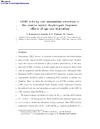Identificador persistente para citar o vincular este elemento:
https://accedacris.ulpgc.es/jspui/handle/10553/7222
| Campo DC | Valor | idioma |
|---|---|---|
| dc.contributor.author | Fernández-Urruzola, Igor | en_US |
| dc.contributor.author | Packard, Theodore T | en_US |
| dc.contributor.author | Gómez, May | en_US |
| dc.contributor.other | Gomez, May | - |
| dc.contributor.other | Packard, Theodore | - |
| dc.contributor.other | Fernandez-Urruzola, Igor | - |
| dc.date.accessioned | 2012-04-10T08:45:55Z | - |
| dc.date.accessioned | 2018-02-21T14:16:58Z | - |
| dc.date.available | 2012-04-10T08:45:55Z | - |
| dc.date.available | 2018-02-21T14:16:58Z | - |
| dc.date.issued | 2011 | en_US |
| dc.identifier.issn | 0022-0981 | en_US |
| dc.identifier.uri | https://accedacris.ulpgc.es/handle/10553/7222 | - |
| dc.description.abstract | Ammonium (NH4+) release by bacterial remineralization and heterotrophic grazers determines the regenerated fraction of phytoplankton productivity, so the measurement of NH4+ excretion in marine organisms is necessary to characterize both the magnitude and the efficiency of the nitrogen cycle. Glutamate dehydrogenase (GDH) is largely responsible for NH4+ formation in crustaceans and consequently should be useful in estimating NH4+ excretion by marine zooplankton.<br />Here, we address body size and starvation as sources of variability on the GDH to NH4+ excretion ratio (GDH/RNH4+). We found a strong correlation between the RNH4+ and the GDH activity (r2 = 0.87, n = 41) during growth. Since GDH activity maintained a linear relation (b = 0.93) and RNH4+ scaled exponentially (b =0.55) in well fed mysids, the GDH/RNH4+ ratio increased with size. However, the magnitude of its variation increased even more when adult mysids were starved. In this case, the GDH/RNH4+ ratio ranged from 11.23 to 102.41. | en_US |
| dc.language | eng | en_US |
| dc.relation.ispartof | Journal of Experimental Marine Biology and Ecology | en_US |
| dc.source | Journal of Experimental Marine Biology and Ecology [ISSN 0022-0981], v. 409 (1-2), p. 21-29 | en_US |
| dc.subject | 251001 Oceanografía biológica | en_US |
| dc.subject.other | Glutamate dehydrogenase | en_US |
| dc.subject.other | Ammonium excretion | en_US |
| dc.subject.other | Leptomysis lingvura | en_US |
| dc.subject.other | Starvation | en_US |
| dc.subject.other | Body size | en_US |
| dc.title | GDH activity and ammonium excretion in the marine mysid, "Leptomysis lingvura": effects of age and starvation | en_US |
| dc.type | info:eu-repo/semantics/Article | en_US |
| dc.type | Article | es |
| dc.type | Article | es |
| dc.identifier.doi | 10.1016/j.jembe.2011.07.035 | |
| dc.identifier.scopus | 82555167024 | |
| dc.identifier.scopus | 82555167024 | - |
| dc.identifier.scopus | 653710 | - |
| dc.identifier.scopus | -;-;1492 | - |
| dc.identifier.isi | 000298363100003 | - |
| dcterms.isPartOf | Journal Of Experimental Marine Biology And Ecology | - |
| dcterms.source | Journal Of Experimental Marine Biology And Ecology[ISSN 0022-0981],v. 409 (1-2), p. 21-29 | - |
| dc.contributor.authorscopusid | 48461211200 | - |
| dc.contributor.authorscopusid | 7004249480 | - |
| dc.contributor.authorscopusid | 7401734371 | - |
| dc.identifier.absysnet | 653710 | - |
| dc.identifier.crisid | -;-;1492 | - |
| dc.description.lastpage | 29 | - |
| dc.description.firstpage | 21 | - |
| dc.relation.volume | 409 | - |
| dc.investigacion | Ciencias | en_US |
| dc.rights.accessrights | info:eu-repo/semantics/openAccess | - |
| dc.type2 | Artículo | en_US |
| dc.identifier.wos | WOS:000298363100003 | - |
| dc.contributor.daisngid | 26127011 | - |
| dc.contributor.daisngid | 4236772 | |
| dc.contributor.daisngid | 311411 | - |
| dc.contributor.daisngid | 1273639 | - |
| dc.identifier.investigatorRID | L-9561-2014 | - |
| dc.identifier.investigatorRID | No ID | - |
| dc.identifier.investigatorRID | No ID | - |
| dc.contributor.wosstandard | WOS:Ferriandez-Urruzola, I | |
| dc.contributor.wosstandard | WOS:Packard, TT | |
| dc.contributor.wosstandard | WOS:Gomez, M | |
| dc.date.coverdate | Diciembre 2011 | |
| dc.identifier.ulpgc | Sí | es |
| dc.description.sjr | 1,067 | |
| dc.description.jcr | 1,875 | |
| dc.description.sjrq | Q1 | |
| dc.description.jcrq | Q2 | |
| dc.description.scie | SCIE | |
| item.grantfulltext | open | - |
| item.fulltext | Con texto completo | - |
| crisitem.author.dept | GIR ECOAQUA: Ecofisiología de Organismos Marinos | - |
| crisitem.author.dept | IU de Investigación en Acuicultura Sostenible y Ec | - |
| crisitem.author.dept | GIR ECOAQUA: Ecofisiología de Organismos Marinos | - |
| crisitem.author.dept | IU de Investigación en Acuicultura Sostenible y Ec | - |
| crisitem.author.dept | Departamento de Biología | - |
| crisitem.author.orcid | 0000-0001-7287-3503 | - |
| crisitem.author.orcid | 0000-0002-5880-1199 | - |
| crisitem.author.orcid | 0000-0002-7396-6493 | - |
| crisitem.author.parentorg | IU de Investigación en Acuicultura Sostenible y Ec | - |
| crisitem.author.parentorg | IU de Investigación en Acuicultura Sostenible y Ec | - |
| crisitem.author.fullName | Fernández Urruzola, Igor | - |
| crisitem.author.fullName | Packard, Theodore Train | - |
| crisitem.author.fullName | Gómez Cabrera, María Milagrosa | - |
| Colección: | Artículos | |
Citas SCOPUSTM
17
actualizado el 08-jun-2025
Citas de WEB OF SCIENCETM
Citations
12
actualizado el 08-jun-2025
Visitas
67
actualizado el 09-dic-2023
Descargas
177
actualizado el 09-dic-2023
Google ScholarTM
Verifica
Altmetric
Comparte
Exporta metadatos
Este elemento está sujeto a una licencia Licencia Creative Commons

